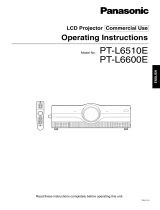
4
Contents
IMPORTANT SAFETY NOTICE ..................................2
Precautions with regard to safety ............................5
Accessories ................................................................7
Precautions on handling ...........................................8
Name and function of parts.......................................9
Remote control ..................................................................9
Front and side of the projector ........................................11
Rear view of the main unit/Controls on rear panel ..........12
Side-mounted connection terminals ................................13
Using the remote control unit .................................14
Loading dry cells .............................................................14
Effective range of remote control operation ....................14
Setting projector ID number to remote control ................15
Connect to the projector to use with a cable ...................15
Installation ................................................................16
Projection schemes .........................................................16
Installation geometry .......................................................16
Projection distance by projection lens .............................17
Calculation formulas for projection distance by lens types
..18
Connection ...............................................................19
Setup precautions ...........................................................19
Example of connecting with AV products ........................20
Example of connecting with PCs.....................................20
Projection..................................................................21
Powering up the projector ...............................................21
Making adjustment and selection ....................................21
Powering off the projector ...............................................22
Direct power off function..................................................22
How to install and remove the projection lens......23
How to install the projection lens.....................................23
How to remove the projection lens ..................................23
How to adjust the lens .............................................23
How to adjust the FOCUS, ZOOM and SHIFT................23
How to adjust the lens position to the left or right............24
Status function .........................................................24
Automatic adjustment (AUTO SETUP)...................24
Using the SHUTTER function..................................24
On-screen menus.....................................................25
Structure of menu screens ..............................................25
Basic menu operations....................................................26
Returning to the previous page .......................................26
Menu items shown in black characters ...........................26
Menu items setting ..........................................................26
Resetting to the factory default........................................26
Adjusting the picture ...............................................27
PICTURE MODE.............................................................27
CONTRAST.....................................................................27
BRIGHTNESS .................................................................27
COLOR............................................................................27
TINT ................................................................................27
COLOR TEMP.................................................................27
WHITE GAIN ...................................................................27
SYSTEM DAYLIGHT VIEW ............................................27
SHARPNESS ..................................................................28
NOISE REDUCTION.......................................................28
AI .....................................................................................28
SYSTEM SELECTOR .....................................................28
Adjusting the position .............................................28
SHIFT ..............................................................................28
ASPECT ..........................................................................28
ZOOM..............................................................................29
CLOCK PHASE...............................................................29
KEYSTONE.....................................................................29
How to use ADVANCED MENU ...............................29
DIGITAL CINEMA REALITY ...........................................29
BLANKING ......................................................................29
INPUT RESOLUTION .....................................................30
CLAMP POSITION..........................................................30
RASTER POSITION........................................................30
XGA MODE .....................................................................30
SXGA MODE...................................................................30
Changing the display language ..............................30
OPTION1 settings.....................................................31
COLOR CORRECTION ..................................................31
CONTRAST MODE.........................................................31
AUTO SIGNAL ................................................................31
BACK COLOR.................................................................31
STARTUP LOGO ............................................................31
SUB MEMORY LIST .......................................................31
DVI EDID.........................................................................32
DVI SIGNAL LEVEL ........................................................32
FUNC1 ............................................................................32
OSD POSITION ..............................................................32
OSD MEMORY ...............................................................32
OPTION2 settings.....................................................33
PROJECTOR ID..............................................................33
INSTALLATION...............................................................33
ALTITUDE .......................................................................33
DIRECTION.....................................................................33
LAMP SELECT................................................................34
LAMP RELAY..................................................................34
RS-232C..........................................................................34
SYSTEM INFORMATION ...............................................35
AUTO POWER OFF........................................................35
DATE AND TIME.............................................................35
PASSWORD ...................................................................35
Displaying the internal test pattern ........................35
Cycle of displayed internal test patterns..........................35
Setting the network..................................................36
Returning the network function setting back to the factory setting
..36
Connecting the PC ...................................................36
System requirements ......................................................36
Connection example........................................................36
Using Web Browser Control ...................................37
Accessing from Web browser..........................................37
Password change page...................................................37
Basic control page...........................................................38
Detail control page ..........................................................39
Monitor information page.................................................39
Error information page.....................................................40
E-mail set up page ..........................................................41
Authentication server set up page...................................42
DNS server set up page ..................................................43
Ping test page .................................................................43
Contents of mail sent.......................................................44
Adjust clock page ............................................................44
Network config page........................................................45
Network status page........................................................45
Using the PJLink
TM
protocol ....................................46
Supported commands .....................................................46
PJLink
TM
security authentication ......................................46
Setting the security..................................................47
PASSWORD ...................................................................47
PASSWORD CHANGE ...................................................47
DISPLAY SETTING.........................................................47
TEXT CHANGE...............................................................47
CONTROL DEVICE SETUP ...........................................47
Using the serial terminals .......................................48
Examples of connection .................................................48
Pin assignments and signal names.................................48
Communication conditions ..............................................48
Basic format ....................................................................48
Control commands ..........................................................49
Cable specifications ........................................................49
Using the Remote 2 terminal...................................49
Indication of lamp monitor ......................................50
Cleaning and replacement of air filter....................51
Procedure of cleaning .....................................................51
Replacing the lamp unit...........................................52
When to replace the Lamp unit .......................................52
Lamp unit replacement steps ..........................................53
Ceiling Mount Bracket Safeguards.........................54
Before asking for service ........................................55
Specifications...........................................................56
Compatible Signal List ............................................58
Dimensions...............................................................59
Installation dimensions diagram ............................59




















